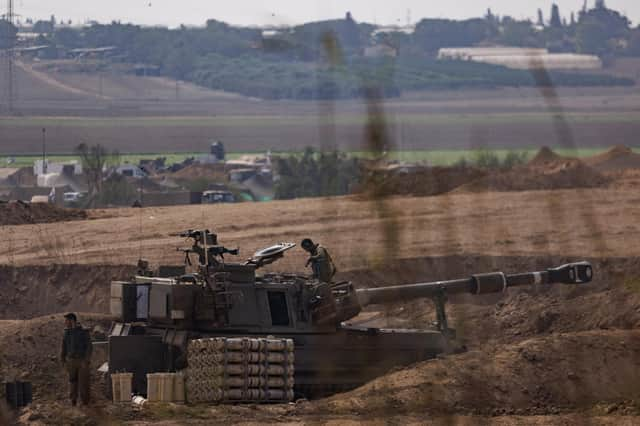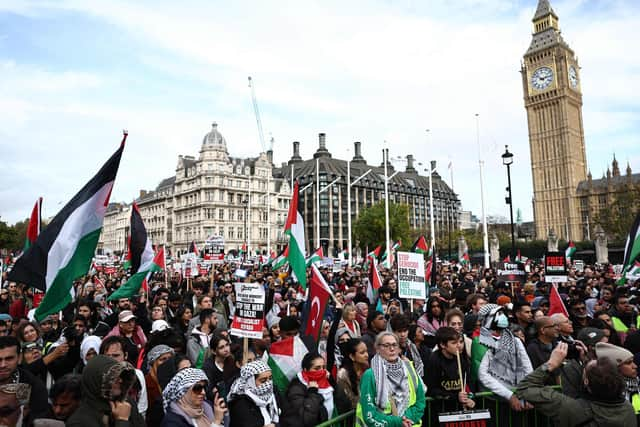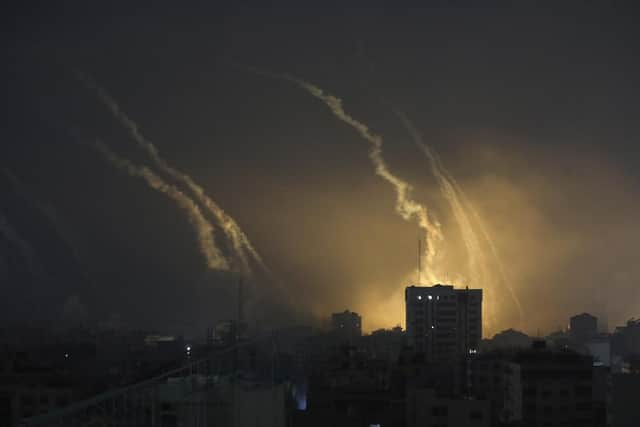Gaza: Israel PM Benjamin Netanyahu says military has opened a “second stage” in the war against Hamas in Gaza


Israeli Prime Minister Benjamin Netanyahu has told his nation that the military has opened a “second stage” in the war against Hamas by sending ground forces into Gaza and expanding attacks from the ground, air and sea.
He said these will only increase ahead of a broad ground invasion into the territory.
Advertisement
Hide AdAdvertisement
Hide AdMr Netanyahu added: “It will be long and difficult. We are ready.”


An Israeli bombardment, described by Gaza residents as the most intense of the war, has knocked out most communications in the territory.
This largely cut off the besieged enclave’s 2.3 million people from the world, while enabling the Israeli military to control the narrative in the new stage of fighting.
The military released grainy images on Saturday showing tank columns moving slowly in open areas of Gaza, many apparently near the border, and said war planes had bombed dozens of Hamas tunnels and underground bunkers.
The underground sites are a key target in Israel’s campaign to crush the territory’s ruling group after its bloody incursion into Israel three weeks ago.


The escalation brought more domestic pressure on Israel’s government to bring about the release of dozens of hostages seized in the October 7 Hamas attack, amid concerns they were being held underground.
Desperate family members met Mr Netanyahu on Saturday and expressed support for an exchange for Palestinian prisoners held in Israel, a swap floated by the top Hamas leader in Gaza.
Mr Netanyahu told the nationally televised news conference that Israel is determined to bring back all the hostages, and maintained that the expanding ground operation “will help us in this mission”.
Advertisement
Hide AdAdvertisement
Hide AdHe said he could not reveal everything that is being done due to the sensitivity and secrecy of the efforts.
“This is the second stage of the war, whose objectives are clear: to destroy the military and governmental capabilities of Hamas and bring the hostages home,” he said in his first time taking questions from journalists since the war began.
He did not address calls for a ceasefire.
Mr Netanyahu acknowledged that the October 7 “debacle”, in which more than 1,400 people were killed after the Hamas attack, would need a thorough investigation, adding that “everyone will have to answer questions, including me”.
The Israeli military said it was gradually expanding its ground operations inside Gaza, while stopping short of calling it an all-out invasion.
“We are proceeding with the stages of the war according to an organised plan,” said the chief military spokesman, Rear Admiral Daniel Hagari. The comments hinted at a strategy of a staged escalation, instead of a massive and overwhelming offensive.
Early in the war, Israel amassed hundreds of thousands of troops along the border. Until now, troops had conducted brief nightly ground incursions before returning to Israel.
Palestinian militants have fired thousands of rockets into Israel over the past three weeks.
The Palestinian death toll in Gaza on Saturday rose to just over 7,700 people since the war began, with 377 deaths reported since late on Friday, according to the Gaza health ministry. A majority of those killed have been women and minors, the ministry said.
Advertisement
Hide AdAdvertisement
Hide AdSpokesman Ashraf al-Qidra told reporters that the disruption of communications has “totally paralysed” the health network. Residents had no way of calling ambulances, and emergency teams are chasing the sounds of artillery barrages and air strikes.
An estimated 1,700 people remain trapped beneath the rubble, according to the health ministry, which has said it bases its estimates on distress calls it has received.
Some civilians were using their bare hands to pull injured people from the rubble and loading them into personal cars or donkey carts.
Israel says its strikes target Hamas fighters and infrastructure and that the militants operate among civilians, putting them in danger.
Rear Admiral Daniel Hagari said “the forces are still on the ground and are continuing the war”.
Earlier yesterday, the military released videos showing columns of armoured vehicles moving slowly in open sandy areas of Gaza, the first visual confirmation of ground troops.
Previously, troops had conducted brief nightly ground incursions before returning to Israel. The move is a further escalation in Israel’s campaign to crush the territory’s ruling militant group Hamas after its bloody incursion in southern Israel three weeks ago and a new sign that Israel is moving closer to an all-out invasion of Gaza.
Late on Friday, Mr Hagari had said ground forces were “expanding their activity” in Gaza and “acting with great force to achieve the objectives of the war”.
Advertisement
Hide AdAdvertisement
Hide AdOvernight into Saturday, warplanes struck 150 tunnels and underground bunkers in northern Gaza, the military said. Hamas’s extensive underground installations, many of them located under Gaza City in the north of the territory, are seen as key targets of the offensive.
As part of the stepped-up bombardment, Israel also knocked out communications and created a near-blackout of information, largely cutting off the 2.3 million people in besieged Gaza from contact with the outside world.
Already plunged into darkness after most electricity was cut off weeks ago, Palestinians were thrown into isolation, huddling in homes and shelters with food and water supplies running out.
Attempts to reach Gaza residents by phone were largely unsuccessful early on Saturday.
Palestinian telecom provider Paltel said the bombardment caused “complete disruption” of internet, cellular and landline services. The cut-off meant that casualties from strikes and details of ground incursions could not immediately be known. Relatives outside Gaza panicked after their messaging chats with families inside suddenly went dead and calls stopped going through.
Wafaa Abdul Rahman, director of a feminist organisation based in the West Bank city of Ramallah, said she had not heard for hours from family in central Gaza. She said: “We’ve been seeing these horrible things and massacres when it’s live on TV, so now what will happen when there’s a total blackout?”
Israel says its strikes target Hamas fighters and infrastructure, and that the militants operate from among civilians, putting them in danger.
The Palestinian death toll in Gaza has soared past 7,300, more than 60 per cent of them minors and women, according to the territory’s health ministry.
Advertisement
Hide AdAdvertisement
Hide AdA blockade on Gaza has meant dwindling supplies and the UN warned that its aid operation helping hundreds of thousands of people was “crumbling” amid near-depleted fuel.More than 1,400 people were killed in Israel during Hamas’s 7 October attack, according to the Israeli government, and at least 229 hostages were taken into Gaza. Among those killed were at least 310 soldiers, according to the military.
In London, Police clashed with protesters as around 100,000 pro-Palestinian demonstrators took to the streets demanding a ceasefire.
Counter demonstrations were also taking place, with dozens of people with Union flags standing close to the Cenotaph on Whitehall, drawing chants of “shame on you” from pro-Palestinian marchers.At least two people were arrested by officers policing the protest. One man was arrested on Whitehall after a police officer was assaulted, the Metropolitan Police announced on X, formerly Twitter. The force said the officer was taken to hospital following the incident.
Police could not say who the arrested man was. Another man was arrested in Waterloo Road on suspicion of a racially aggravated public order offence and making threats to kill. It was not immediately clear whether the people arrested were taking part in the protest or a counter demonstration.
Police were also seen clashing with pro-Palestinian protesters.
Officers appeared to detain someone close to Downing Street before demonstrators began scuffling with them. Punches and kicks were thrown and officers ordered the demonstrators to move away.
There were also marches in Edinburgh, Glasgow, Dundee, Aberdeen, Stirling, Greenock and Forres.